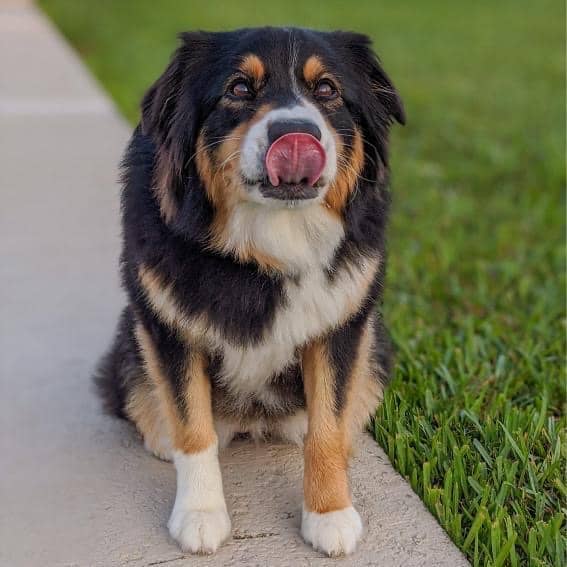
You are all happy with your Aussie puppy and trying to get everything ready and prepared. Then, you come across the question: what should I feed my Aussie?
There are so many different types of dog diets out there today. It can be very overwhelming and challenging to choose the right diet for your Aussie.
This article has no hidden intention to tell you what brand or diet type to pick. Instead, if has information to help you make the best choice from an educated standpoint. A happy Aussie is a healthy Aussie!
Commercials and ads have many ideas created by business executives and marketing teams. How do we know what to believe? What is medically and scientifically reliable? Our goal is to discuss factors you must keep in mind while choosing an appropriate food for your Aussie.
What Should I Feed my Aussie?
The dog diet subject can be quite controversial. People can become fanatical when it comes to defending their diet of choice. For example: natural vs. commercial, raw vs. cooked, grain-free or with grains, etc.
There are some important facts we have to consider when choosing our dog’s source of nutrition.
Different breeds, different ages, and different health conditions have different nutritional needs. So, there is not a specific, universal diet that will fit all dogs. We will describe the process of how diets form, so we can understand that a little better.
Create a Nutrient Profile
Every diet has a specific nutrient profile. A nutrient profile is the precise nutrient balance to target your dog’s needs. Here are some examples of dietary needs:
Choose High Quality Ingredients
Now, it’s time to choose high-quality ingredients that will deliver those desired nutrients. The ingredients serve as the vehicles to take nutrients through the digestive tract. This is so they can absorb. One ingredient may be able to deliver many of the desired nutrients.
The diet’s ingredient choice should focus on its nutritional content. Pay attention to quality, digestibility, palatability, and functionality.
This is the part that can be a bit confusing. Some pet food producers choose ingredients according to what is trendy with humans. This ignores your pet’s proper nutritional content, digestibility, and palatability.
Consider science and testing when choosing the right diet for your Australian Shepherd. Dogs and cats have very different nutritional needs than humans, so they should not eat only what we eat. Tempting ingredients to us may not always be the best source of nutrients for your furry friend. Remember: these animals also lick their you know where and hunts lizards!)

When choosing a brand of dog food, you MUST question a few things.
1.) Can you verify veterinary, scientific research that supports the represented Pet Food Company. Research must support the choice of ingredients. It must meet the age, weight/size, lifestyle, and health-specific needs of the particular pet.
2.) Does your Pet Food Company own the manufacturing facility? Does it stand behind the quality of its food? Some Food Companies have their diet made in shared facilities. Because of this, the product can get exposed to contaminants. Thus, the quality of the diet is at risk. The food can become toxic with substances that are not supposed to be there.
3.) Does the manufacturer meet certification standards for quality manufacturing ? (ISO Food Safety and Handling Standards)
Vet Help
Diets are definitely not “one size fits all.” ALWAYS consult a veterinarian when in doubt about a specific diet. Your veterinarian can work with you to transition your pet from one food to another. Switching foods “cold-turkey” is never recommended. It may even cause adverse symptoms like diarrhea and vomiting.
Next, we discuss more about some of the ingredients that can cause a lot of controversy among pet owners. Once again, my intent is not to convince you to like or dislike any ingredient. Here are some scientific-based facts behind ingredients so you can make your own, well-informed decision.
Animal By-Products. What are they?
The name By-Product is from a human perspective, so I can see why it can be a bit misleading.
Animal by-products are nutrient-dense internal organs of animals. Offering digestible and sustainable ways of providing the nutrients dogs and cats need. We are referring to the heart, liver, and lungs.
Due to some loose regulations, Food Companies have to put this term on labels. These ingredients are not appealing to humans. But, we have to remember that pets and humans have very different nutritional needs. The fact that a human would rather not consume those parts does not mean that they are not nutritional to pets.
Corn – Is it just a filler? Can pets digest it? Can it cause Allergies?
Corn is actually an excellent source of nutrition. It is one of the few ingredients that contain fiber, carbohydrates, protein, fat, minerals, and vitamins. It can be easily digested when appropriately processed in pet foods. (finely ground corn)
Some of the fiber is not digestible, which is a good thing. This helps the intestines to absorb water and form stool, preventing constipation.
*Allergies are often caused by the protein source of food. For example, chicken, beef, etc. There is nothing allergenic in corn. *

Chicken Meal vs Real Chicken- DING DING!
This is another example where the term that is used can throw you off. 70% of the chicken is water and the other 30% are bone, meat, and fat. Chicken meal is nothing more than chicken after the removal of water and fat.
If the chicken was used in place of chicken meal, it would require more volume, calories, and fat to achieve the same desired protein amount. So the chicken meal is actually a high quality, concentrated protein and it is also easily digested.
What about Grain-Free Diets?
Lately, grain-free diets have been in this spotlight since they have been linked to a severe health condition in dogs called Dilated Cardiomyopathy (DCM). But what exactly is it?
Dilated Cardiomyopathy (DCM) is a progressive disease of the heart muscle. The heart becomes larger and weaker and is not able to pump adequate amounts of blood through the circulatory system. This can lead to heart failure and death.
It is known that the deficiency of an amino acid called Taurine is one of the causes of DCM. Taurine is especially concentrated in the heart muscle and contributes to proper heart function.
Amino Acids
Amino acids are the basic building blocks that will form the protein. Taurine is an essential amino acid, which means it cannot be produced by the body and needs to be supplied by the diet.
Research is still ongoing and the question remains whether the DCM is caused by overall lack of taurine in the diet or other dietary factors that interfere with its digestion, absorption, metabolism, and/or excretion.

To find more information about diets and their relationship with this disease check out the FDA website at:
https://www.fda.gov/animal-veterinary/outbreaks-and-advisories/fda-investigation-potential-link-between-certain-diets-and-canine-dilated-cardiomyopathy
Keep in mind is that there is no scientific resource to prove that a grain-free diet is superior to one with grains. But, recent studies have shown that dogs eating grain-free diets had more advanced DCM than those eating grain-based diets.
Always ask your veterinarian any questions you have about your Australian Shepherd’s diet. Research the company and brand you want to use. Make sure they work according to quality standards. Be sure your dog does not have any specific nutrient needs that are not in that specific diet.
Follow these guidelines and know you are feeding your Aussie the best quality food he/she needs. Your Australian Shepherd will live a healthy and happy life!





